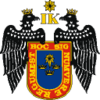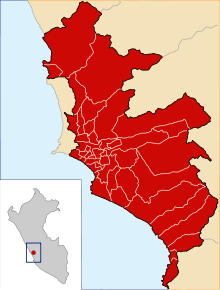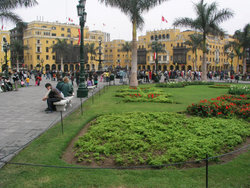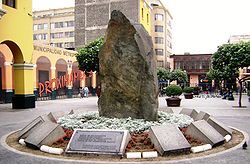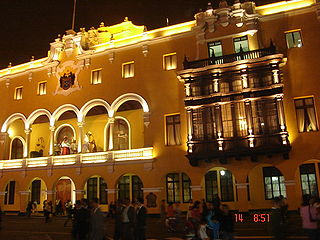- Lima Province
-
This article is about the province. For its capital city, see Lima. For other uses, see Lima (disambiguation).
Lima — Province —
Coat of armsLocation of Lima Province in Lima Country  Peru
PeruRegion Lima Founded January 18, 1535 Capital Lima Districts 43 Area – Total 2,672.28 km2 (1,031.8 sq mi) Population (2007)[1] – Total 7,605,742 – Density 2,846.2/km2 (7,371.5/sq mi) Time zone PET (UTC-5) Website www.munlima.gob.pe Lima Province is located in the central coast of Peru and is the only province in the country not belonging to any of the twenty-five regions. Its capital is Lima, which is also the nation's capital.
Despite its small area, this province is the major industrial and economic powerhouse of the Peruvian economy. It concentrates almost one-third of country's population and much of its GDP.
Contents
History
The province was created in 1821 as Peru's territory was divided into departments, provinces, districts and parishes. The province was part of the Lima Department, which was formed by the territories of present day Lima, Callao and Ica regions, and the provinces of Casma, Huarmey and Santa, which later would be part of the La Costa Department.
The department was further subdivided as time passed but the Lima Province kept being part of it. Due to the massive migration from other areas of the country, the need to separate the province from the rest of the department was forecast by experts.
In 2002, the new regionalization law passed by President Alejandro Toledo made the Lima Province a separate entity from the rest of the newly created Lima Region.
Political division
- Main article: Districts of Lima
The province is divided into 43 districts. Each of them is headed by a mayor, although the Metropolitan Lima Municipal Council (Municipalidad Metropolitana de Lima), led by the mayor of Lima, also exercises its authority in these districts.
All the districts of Lima province are fused together in a continuous urban area, with the exception of the beach resorts of Ancon and Santa Rosa in the north and Pachacamac, Punta Hermosa, Punta Negra, San Bartolo, Santa Maria del Mar and Pucusana in the south.
Boundaries
- North: Huaral Province
- Northeast: Canta Province
- East: Huarochirí Province
- South: Cañete Province (all of these four provinces are in the Lima Region)
- West: Callao Region and the Pacific Ocean
Government
Lima Province is administered by the Metropolitan Municipality of Lima (Municipalidad Metropolitana de Lima), which also administers the city of Lima. Its current mayor is Susana Villarán de La Puente.
Climate
From April to December, Lima is often covered in coastal fog and mist, while in January to late March, the weather is generally sunny.[2]
Tourism
Lima has various tourist destinations and activities, including pre-Inca period pyramids, museums and modern shopping malls.[2] There are many restaurants, some of which specialize in fresh seafood, bars and nightclubs.[2] There are many beaches for sunbathing, swimming and fishing.[2]
References
- ^ INEI. Censos Nacionales 2007: XI de Población y VI de Vivienda. Primeros Resultados. (pdf-file, 1453 kB) 2007 Population Census, first results. Retrieved on 2008-11-09.
- ^ a b c d Lima Travel Information from Lonely Planet Travel Guides and Travel Information. Retrieved August 2009.
External links
- (Spanish) Municipalidad Metropolitana de Lima Metropolitan Lima Municipal Council official website
 Regions of Peru
Regions of PeruAmazonas · Ancash · Apurímac · Arequipa · Ayacucho · Cajamarca · Callao · Cusco · Huancavelica · Huánuco · Ica · Junín · La Libertad · Lambayeque · Lima · Loreto · Madre de Dios · Moquegua · Pasco · Piura · Puno · San Martín · Tacna · Tumbes · Ucayali
Peru's Lima Province is not part of any region.Categories:
Wikimedia Foundation. 2010.

